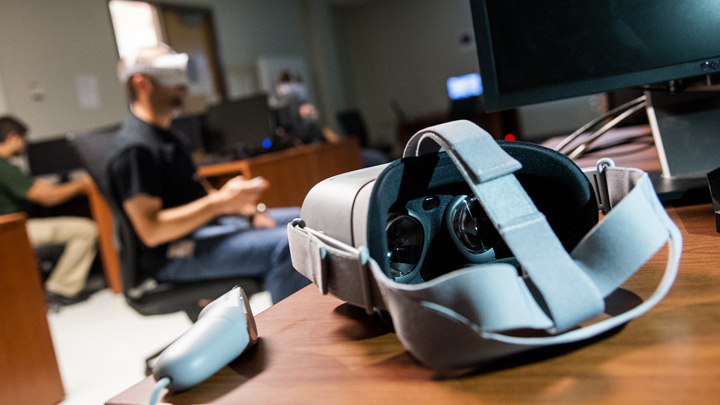University
Technology Enhances Learning for Pharmacy Students

By Sandra C. Roa, USF News
Virtual (VR) and augmented (AR) realities are transforming the way pharmacology students learn at the USF College of Pharmacy. First-year students are using simulation goggles to see how certain drugs interact in the body. They applied AR/VR to visualize how beta blockers commonly prescribed to treat hypertension, asthma and cardiac workload may affect the heart, lungs and blood vessels. This new learning experience is part of a key initiative to integrate advanced technologies into the student curriculum.
“As dean, I teach an advanced metabolic syndrome course, and I have always wanted the student to have high-fidelity visualization of the medications we use to treat diabetes and heart disease. With AR/ VR, we are now able to conceptualize organ function better, soon followed by complex medication mechanisms of action,” Kevin Sneed, dean of the College of Pharmacy, says.
Students covered their eyes with headsets and chose from components previously learned in class. They used a laser beam to drag and drop small doses onto an organ to witness a reaction. In some treatments the heart beat faster, the lungs expanded, or blood vessels constricted.
“They are able to really play with and really understand which drugs are causing the constriction, which would lead to increased hypertension,” Daniel Lee, associate professor of pharmaceutical science, says.
This program is just the beginning. Feedback from participating students will be factored into future modules. Faculty from the college will continue to work closely with Information Technology’s Advanced Visualization Center (AVC) at USF to keep the technology fresh. A student technology fee initiative funds the program.
“It’s a great collaboration that shows the spirit of USF,” Howard Kaplan, advanced technologies manager at AVC, says.
Kaplan’s team develops mechanisms for learning inside augmented and virtual realities with many departments across the university to innovate curricula, enhance research projects and inspire more uses of new technologies.
“I wish I had something like this when I was learning pharmacology,” Lee says. “It’s very interactive.”
View a video of first-year pharmacology students using simulation goggles to see how certain drugs interact in the body.